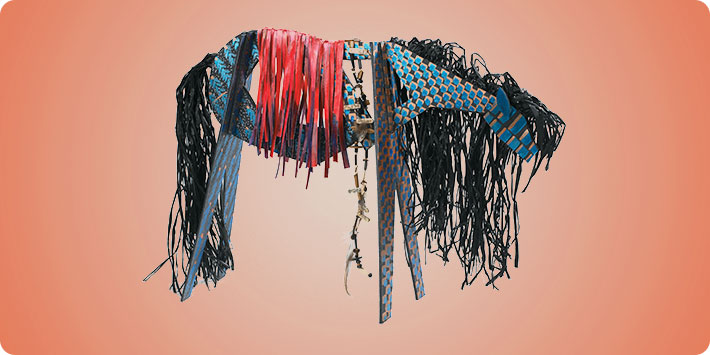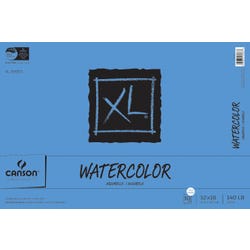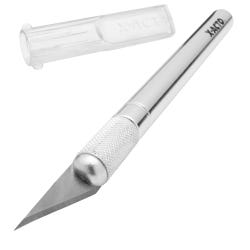A Horse of a Different Pattern

Description
Countless artists have created horses in abstract form, using simplified shapes from nature to suggest their essence. Sculptor Alexander Calder did so with his stabiles (STAY-beels), which marry balance and design; Debbie Butterfield crafted horses in bronze; and Edgar Degas captured racehorses with paint. Drawing on what they learn about abstract art from works like these, your students can use simple materials to create 3-D abstract horses reminiscent of Alexander Calder's stabiles in a mixed-media lesson that crosses the visual arts with science and history.
Objectives
- Students will use foam core board to construct 3-D abstract horses and will adorn them with culturally meaningful patterns. Students will employ concepts of science in integrating balance in their stabile design. Students will explore the historical context of abstract art.
Supplies Needed
Elmer's® Black-on-Black Foam Core Board 447329
X-ACTO® Knife 573149
Sargent Art® Liquid Metallics 6-color set, 8-ounce jars 405594
6-color set, 4-ounce jars 409187
Prang® Metallic Art Markers 410403
Sax® Multimedia Varnish 403960
Canson® XL Watercolor Pad, 12"x18" 1371709
Elmer's® Craft Bond Tacky Glue 024103
Bone Beads 401550
Professional Jewelry String Wire 1428983
Sax Flame-Resistant Mildewproof Madagascar Raffia, 12 oz, Vari-Color, 1 lb, Pack 227133
Dahle® Vantage Self-Healing Cutting Mat 409206
Paintbrushes
Clamps
Metal rulers or yard sticks
Resources:
Drawing Animals 464246
Standards
CONTENT Standard #1: Using and applying media, techniques and processes
CONTENT Standard #4: Understanding the visual arts in relation to history and cultures
CONTENT Standard #5: Reflecting upon and assessing the characteristics and merits of their work and the work of others
CONTENT Standard #6: Making connections between visual arts and other disciplines"
Instructions
Teacher preparation:
Gather resources that illustrate and explain Alexander Calder's stabiles. Find other artistic examples of animals in abstract form, including Debbie Butterfield's bronze horse sculptures and Edgar Degas' Racehorses.With the students: Provide a definition of abstract art. Share abstract animal art by Butterfield, Calder, Degas and others. Discuss Calder's stabiles, contrasting them with his mobiles.
1
Examine the use of pattern and its role in lending visual interest and expressing culture and emotion in artwork.
2
Using a drawing, photograph or horse model as a guide, quickly sketch a horse to capture its essence and abstract shape, noting its different positions.
3
Based on the sketches, draw stabile templates on tag board, including sections for the body and legs and using two layers as necessary to sandwich elements like a mane and tail in place. Incorporate slits or channels in the leg sections so that they nest at 90-degree angles to the body, allowing the stabile to stand on its own.
4
Cut out the templates. Experiment with proportions, head size/position, contact points and joints to refine the templates, modifying or adding sections so that the stabile is self-supporting and balanced when assembled.
5
Trace two copies of the refined templates on tag board. Cut one out and glue it together to verify the design's stability. Refine the remaining template as necessary.
6
Trace the further refined template on to foam core board, remembering to widen the nesting channels to accommodate the board's thickness. Cut out the sections with an X-ACTO® knife on a self-healing cutting mat. Use a metal-edged ruler to cut straight lines.
7
Adorn the sections with decorative patterns using acrylic paint or markers. Dry.
8
To make a permanently assembled stabile, glue legs to body. To make a stabile that disassembles for flat storage.
9
Cut eight long, thin strips of foam core board.
10
Position the legs on the body so the stabile is balanced. Lightly trace the legs' position, both in front of and behind each leg and on each side of the body.
11
Outside each of the eight lines traced, glue a thin strip of foam core board perpendicular to the body, making slots into and out of which the front and back leg sections will slide.
12
If desired, embellish the horse. Glue on raffia for a mane and tail, add painted strips of watercolor paper for a pony blanket and incorporate beads for a cultural touch.
13
Present stabiles in class, assessing variations in design, balance and construction.




